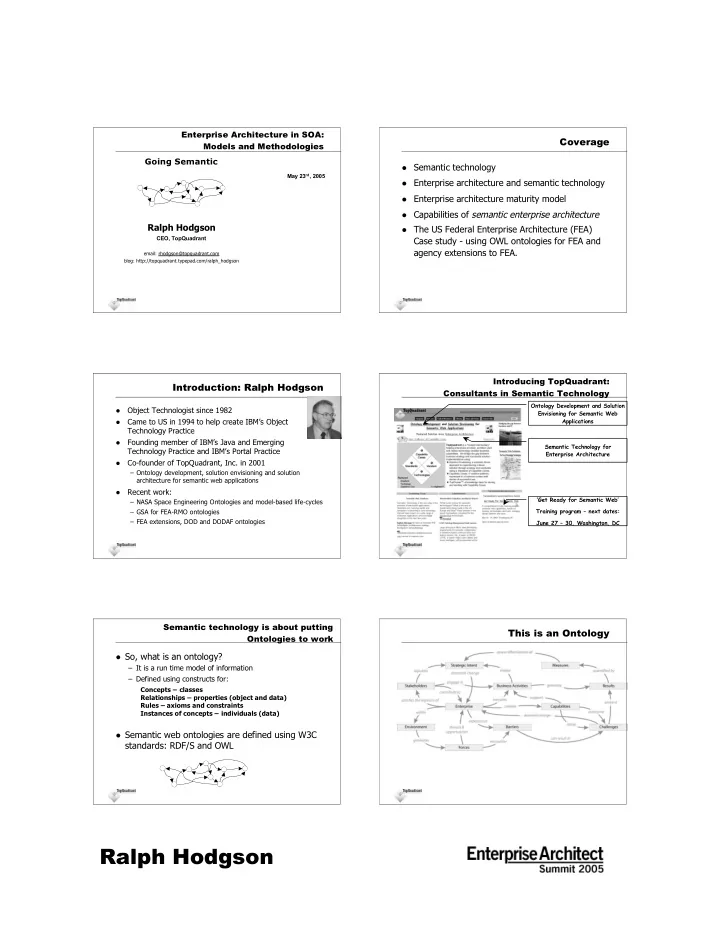

Enterprise Architecture in SOA: Coverage Models and Methodologies Going Semantic Semantic technology May 23 rd , 2005 Enterprise architecture and semantic technology Enterprise architecture maturity model Capabilities of semantic enterprise architecture Ralph Hodgson The US Federal Enterprise Architecture (FEA) CEO, TopQuadrant Case study - using OWL ontologies for FEA and agency extensions to FEA. email: rhodgson@topquadrant.com blog: http://topquadrant.typepad.com/ralph_hodgson Introducing TopQuadrant: Introduction: Ralph Hodgson Consultants in Semantic Technology Ontology Development and Solution Object Technologist since 1982 Envisioning for Semantic Web Came to US in 1994 to help create IBM’s Object Applications Technology Practice Founding member of IBM’s Java and Emerging Semantic Technology for Technology Practice and IBM’s Portal Practice Enterprise Architecture Co-founder of TopQuadrant, Inc. in 2001 – Ontology development, solution envisioning and solution architecture for semantic web applications Recent work: ‘Get Ready for Semantic Web’ – NASA Space Engineering Ontologies and model-based life-cycles – GSA for FEA-RMO ontologies Training program – next dates: – FEA extensions, DOD and DODAF ontologies June 27 – 30, Washington, DC Semantic technology is about putting This is an Ontology Ontologies to work So, what is an ontology? – It is a run time model of information – Defined using constructs for: Concepts – classes Relationships – properties (object and data) Rules – axioms and constraints Instances of concepts – individuals (data) Semantic web ontologies are defined using W3C standards: RDF/S and OWL Ralph Hodgson
Realizing a semantic solution: Ontologies are like and unlike other IT models Required Components Like databases ontologies are used by applications Triple Store: at run time (queried and reasoned over) – Kowari, Oracle, RDFGateway™, Sesame Query Engine: – Unlike databases, relationships are first-class constructs – RDFGateway, Cerebra, HP Jena Like object models ontologies describe classes and Inferencing Engine: attributes (properties) – Cerebra™, OntoBroker, Pellet, Racer, … Application Builder: – Unlike object models, ontologies are set-based – RDFGateway™, Haystack Like business rules they encode rules Visualization: – K-Infinity™, GraphViz, – Unlike business rules, ontologies organize rules using Ontology Builder: axioms – Protégé, SWOOP, … Like XML schemas they are native to the web (and Content Acquirers: are in fact serialized in XML) – Translators, Scripts, TopBraid™, Semagix Freedom™, … – Unlike XML schemas, ontologies are graphs not trees and used for reasoning Realizing a semantic solution: An Impressive list of vendors are adopting Vertical Application Platforms Semantic Web Standards Knowledge and Content Management Adobe – Semagix BT – SemanTX Life Sciences Cisco – Siderian IBM – Profium Oracle Semantic Interoperability – Cerebra SAP – OntoBroker Software AG – OntologyWorks Verio IT Management … – Metallect – Unicorn Solutions Large Enterprises with Why is semantic technology relevant to Semantic Web Pilots in Progress Enterprise Architecture? An EA is a model of an Audi enterprise expressing Daimler Chrysler how: GE – people in roles, GM – performing activities, HP – using capabilities, Microsoft – provided by systems and resources, NASA – overcome challenges and Sun generate value Time Warner – with measurable results US Customs for realizing business goals US GSA Cisco This is a “Knowledge Model”. … source of the plan: www.nzherald.co.nz/index.cfm?ObjectID=10007286, Semantic Web Technologies http://media.apn.co.nz/webcontent/image/gif/districtplan.GIF are about modeling knowledge Ralph Hodgson
Ontology can express the relationships in the Semantic Systems infer answers Enterprise Architecture from a knowledge base Bridges the gaps “Connects the dots” across: Stakeholders What do I depend on Business, technology and IT models between business, to be effective? technology and IT “Line of Sight” across: Intents extended enterprise business units within business units Makes Value Nets to measures of effectiveness “Navigate-able” Activities Capability knows: What outcomes does why it exists, what enterprise activities need it used, this activity support? what it depends on, Makes Capabilities Capabilities its measures of effectiveness “Knowledge-able” Component knows: where it is used, how it is realized, Makes Components what it depends on, Systems its measures of effectiveness Who is using what “Knowledge-able” systems to do what? Knowledge Model using Semantic Technology Behavior Model for inferencing Federated Architecture Uses Semantic- Analytical Tools Decision Support Enabled Collaborative Data can come from a variety of sources. Semantic model Tools merges and integrates. Enterprise Architecture Maturity Model Enterprise Architecture Maturity Levels Executable 5 . Models are consultable by applications at run time. Knowledge about enterprise activities, systems & capabilities becomes a real time resource. Federated 4 . Connections between different systems and tools are established. Formal 3 . Methodology enforced by tools based on a “Reference architecture”. Multiple tools in use, but from different vendors with low levels of interoperability. Reference framework and Standardized architectural models cannot be readily queried. 2 . Established methodology for describing architectures. Use of industry Ad hoc standard/custom framework. Methodology not fully supported and enforced by tools. 1 . No common reference framework. Possible use of case tools. Little commonality between descriptions produced by different people and/or groups. Enterprise Architecture Capabilities Enterprise Architecture Technologies Executable Executable Benefits Adaptive enterprise Improved enterprise agility. Real-time decision support and capability re-configuration of capabilities. Models stay in-sync with the real world. OWL, management and Federated Federated web services, service provisioning SWRL, agents Architectural models are accessible across organizational contexts. Information can be independently constructed, aggregated and made accessible to wide audiences. XML data exchange, Formal Aggregation and exchange Formal web-based repositories, of data and metadata. Architects can adhere to the framework. RDF/S Improved productivity of architects as well as Federated IT governance improved fidelity of models. Standardized “What-If” analysis, reports. Standardized Case tools, taxonomies Architectural models produced by different Centralized IT governance groups can be understood more easily. Linkages can be described. EA framework compliance Ad hoc Templates,spreadsheets Ad hoc Some sharing of architectural ideas. Document provisioning Capabilities Personal computers and office tools Ralph Hodgson
Recommend
More recommend